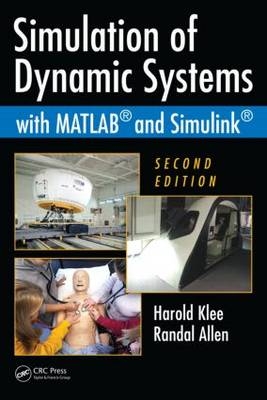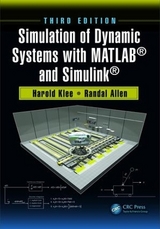
Simulation of Dynamic Systems with MATLAB and Simulink, Second Edition
Crc Press Inc (Verlag)
978-1-4398-3673-6 (ISBN)
- Titel erscheint in neuer Auflage
- Artikel merken
—From the Foreword by Chris Bauer, PhD, PE, CMSP
Continuous-system simulation is an increasingly important tool for optimizing the performance of real-world systems, and a massive transformation has occurred in the application of simulation in fields ranging from engineering and physical sciences to medicine, biology, economics, and applied mathematics. As with most things, simulation is best learned through practice—but explosive growth in the field requires a new learning approach.
A response to changes in the field, Simulation of Dynamic Systems with MATLAB® and Simulink®, Second Edition has been extensively updated to help readers build an in-depth and intuitive understanding of basic concepts, mathematical tools, and the common principles of various simulation models for different phenomena.
Includes an abundance of case studies, real-world examples, homework problems, and equations to develop a practical understanding of concepts
Accomplished experts Harold Klee and Randal Allen take readers through a gradual and natural progression of important topics in simulation, introducing advanced concepts only after they construct complete examples using fundamental methods. Presented exercises incorporate MATLAB® and Simulink®—including access to downloadable M-files and model files—enabling both students and professionals to gain experience with these industry-standard tools and more easily design, implement, and adjust simulation models in their particular field of study.
More universities are offering courses—as well as masters and Ph.D programs—in both continuous-time and discrete-time simulation, promoting a new interdisciplinary focus that appeals to undergraduates and beginning graduates from a wide range of fields. Ideal for such courses, this classroom-tested introductory text presents a flexible, multifaceted approach through which simulation can play a prominent role in validating system design and training personnel involved.
Dr. Harold Klee received his Ph.D in systems science from Polytechnic Institute of Brooklyn in 1972, his MS in systems engineering from Case Institute of Technology in 1968, and his BSME from The Cooper Union in 1965. Dr. Klee has been a faculty member in the College of Engineering at the University of Central Florida (UCF) since 1972. During his tenure there, he has been a five-time recipient of the college’s Outstanding Teacher Award. He has been instrumental in the development of simulation courses in both the undergraduate and graduate curricula. A charter member of the Core Faculty of the Institute of Simulation and Training, which is responsible for developing the interdisciplinary MS and Ph.D programs in simulation at UCF, Dr. Klee has served as the director of the UCF Driving Simulation Lab for more than 15 years, and he has been editor in chief of the Modeling and Simulation magazine for three years. Dr. Randal Allen has over 20 years of industry experience and is currently an aerospace and defense consultant working under contract to provide 6DOF aerodynamic simulation, modeling, analysis, design, integration, and test of navigation, guidance, and control systems. His previous experience includes launch systems integration and flight operations for Titan-IV missions, propulsion modeling for the Iridium satellite constellation, and field application engineering for MATRIXx. He is an Associate Fellow of the American Institute of Aeronautics and Astronautics (AIAA) and is the current chairperson the Central Florida Section. He is certified as a modeling and simulation professional (CMSP) by the National Training and Simulation Association (NTSA) and also certified to deliver Franklin-Covey’s Focus and Execution track which provides training on achieving your highest priorities. Dr. Allen’s academic background includes a Ph.D. in Mechanical Engineering from the University of Central Florida, an Engineer’s Degree in Aeronautical and Astronautical Engineering from Stanford University, an M.S. in Applied Mathematics and a B.S. in Engineering Physics, both from the University of Illinois (Urbana-Champaign). He also serves as an Adjunct Professor in the Mechanical, Materials, and Aerospace Engineering (MMAE) department at the University of Central Florida (UCF) in Orlando, Florida.
Mathematical Modeling
Derivation of a Mathematical Model
Difference Equations
First Look at Discrete-Time Systems
Case Study: Population Dynamics (Single Species)
Continuous-Time Systems
First-Order Systems
Second-Order Systems
Simulation Diagrams
Higher-Order Systems
State Variables
Nonlinear Systems
Case Study: Submarine Depth Control System
Elementary Numerical Integration
Discrete-Time System Approximation of a Continuous-Time Integrator
Euler Integration
Trapezoidal Integration
Numerical Integration of First-Order and Higher Continuous-Time Systems
Improvements to Euler Integration
Case Study: Vertical Ascent of a Diver
Linear Systems Analysis
Laplace Transform
Transfer Function
Stability of Linear Time Invariant Continuous-Time Systems
Frequency Response of LTI Continuous-Time Systems
z-Transform
z-Domain Transfer Function
Stability of LTI Discrete-Time Systems
Frequency Response of Discrete-Time Systems
Control System Toolbox
Case Study: Longitudinal Control of an Aircraft
Case Study: Notch Filter for Electrocardiograph Waveform
Simulink®
Building a Simulink® Model
Simulation of Linear Systems
Algebraic Loops
More Simulink® Blocks
Subsystems
Discrete-Time Systems
MATLAB® and Simulink® Interface
Hybrid Systems: Continuous- and Discrete-Time Components
Monte Carlo Simulation
Case Study: Pilot Ejection
Case Study: Kalman Filtering
Intermediate Numerical Integration
Runge–Kutta (RK)—One-Step Methods
Adaptive Techniques
Multistep Methods
Stiff Systems
Lumped Parameter Approximation of Distributed Parameter Systems
Systems with Discontinuities
Case Study: Spread of an Epidemic
Simulation Tools
Steady-State Solver
Optimization of Simulink® Models
Linearization
Adding Blocks to the Simulink® Library Browser
Simulation Acceleration
Advanced Numerical Integration
Dynamic Errors (Characteristic Roots, Transfer Function)
Stability of Numerical Integrators
Multirate Integration
Real-Time Simulation
Additional Methods of Approximating Continuous-Time System Models
Case Study: Lego Mindstorms NXT
| Erscheint lt. Verlag | 25.2.2011 |
|---|---|
| Zusatzinfo | N/A; Over 2,000; 68 Tables, black and white; 765 Illustrations, black and white |
| Verlagsort | Bosa Roca |
| Sprache | englisch |
| Maße | 178 x 254 mm |
| Gewicht | 1500 g |
| Themenwelt | Mathematik / Informatik ► Informatik ► Theorie / Studium |
| Technik ► Elektrotechnik / Energietechnik | |
| ISBN-10 | 1-4398-3673-6 / 1439836736 |
| ISBN-13 | 978-1-4398-3673-6 / 9781439836736 |
| Zustand | Neuware |
| Informationen gemäß Produktsicherheitsverordnung (GPSR) | |
| Haben Sie eine Frage zum Produkt? |
aus dem Bereich



